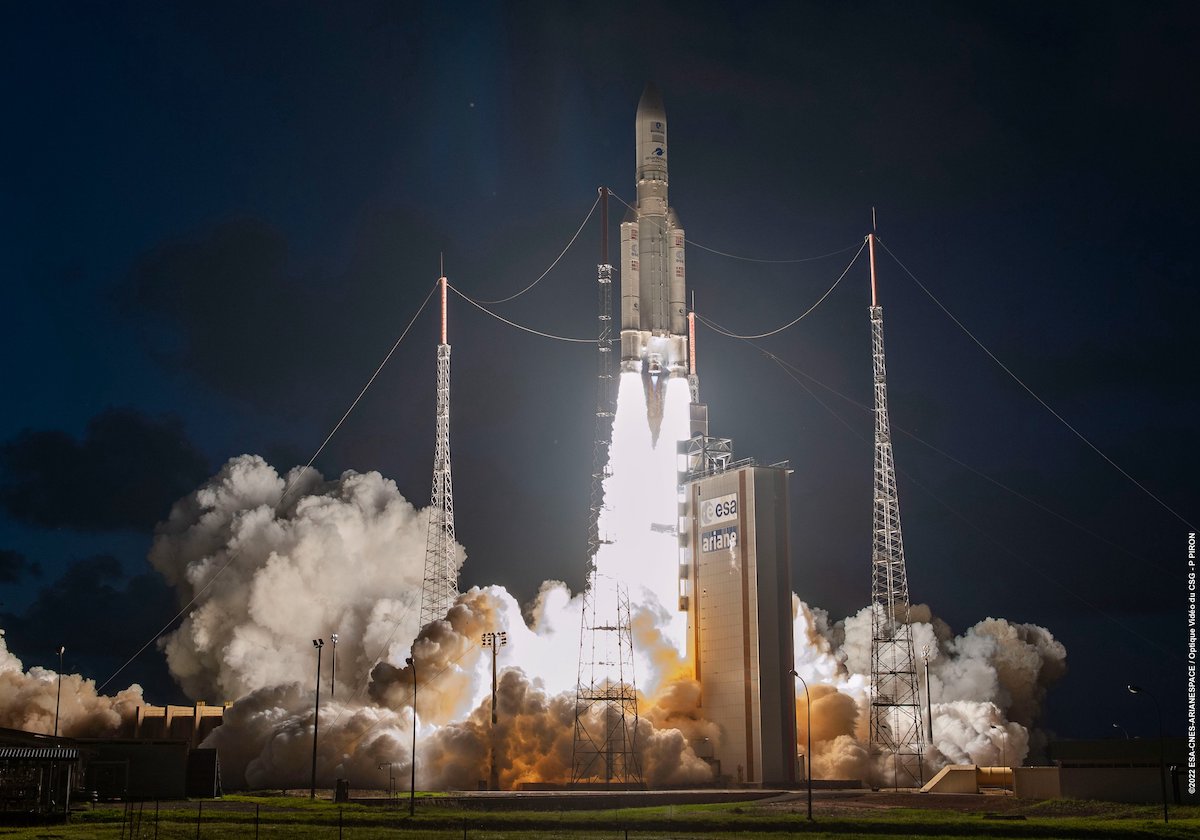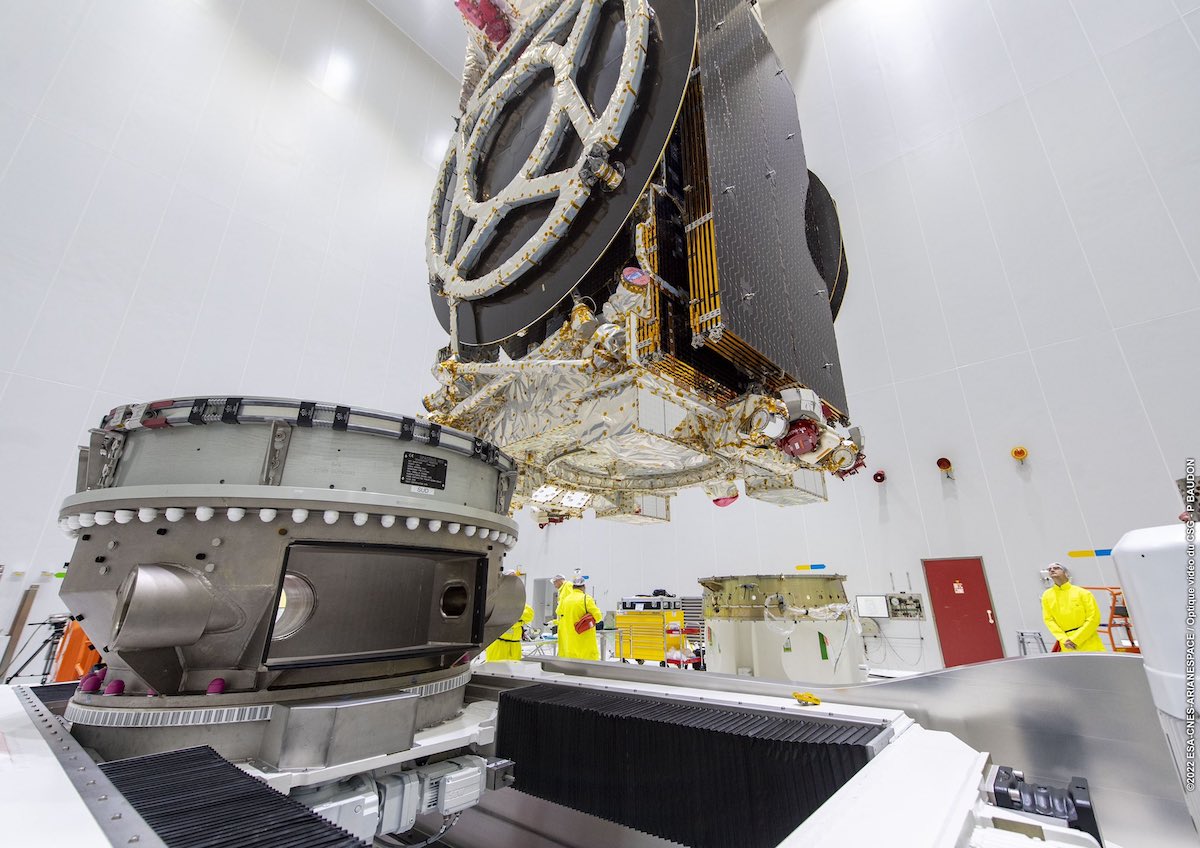
A powerful Eutelsat commercial communications satellite launched Wednesday aboard an Ariane 5 rocket from French Guiana, heading into orbit on a mission expected to last more than 15 years to provide broadband connectivity to rural households, ships, and airplane passengers across Europe.
The Eutelsat Konnect VHTS satellite was the sole payload aboard the Ariane 5 rocket as it vaulted off its launch pad at the European-run Guiana Space Center Wednesday. Liftoff of the 180-foot-tall (55-meter) rocket occurred at 5:45 p.m. EDT (2145 GMT) from the ELA-3 launch zone at the jungle spaceport in French Guiana.
The new Eutelsat spacecraft weighed more than 7 tons (about 6.4 metric tons) at launch, and will provide Ka-band connectivity for European markets, including fixed broadband customers — such as homes and businesses — and in-flight WiFi users flying across Europe on airliners. The satellite’s main body stands about 29 feet (8.8 meters) tall, as high as a three-story building.
Running a day late due to unfavorable upper level winds, the Ariane 5 rocket lit its hydrogen-fueled Vulcain 2 main engine as the countdown clock reached zero. Seven seconds later, the Ariane 5 ignited two side-mounted solid rocket boosters to propel the launcher off the pad with 2.9 million pounds of thrust.
The rocket headed east from the launch pad, surpassed the speed of sound in less than a minute, and jettisoned its two spent solid-fueled boosters nearly two-and-a-half minutes into the flight. Ground-based tracking cameras showed the spent booster casings veering away from the Ariane 5’s core stage as the rocket soared into sunlight.
The Ariane 5 released its Swiss-made payload fairing about a minute later, then shut down its Vulcain 2 engine nearly minutes after liftoff. A cryogenic upper stage powered by an HM7B engine fired around 16 minutes to place the Eutelsat Konnect VHTS spacecraft into an egg-shaped “supersynchronous” transfer orbit ranging as high as 37,500 miles (60,351 kilometers) above Earth.
The target inclination for the transfer orbit was 3.5 degrees to the equator, enabled by the Ariane 5’s launch site in the tropics of South America. The rocket released the Eutelsat satellite nearly 29 minutes after launch, prompting a round of applause at the launch control center in French Guiana.
Eutelsat Konnect VHTS will unfurl its solar panels and use its low-thrust but fuel-efficient plasma engines to maneuver into its final circular geostationary orbit more than 22,000 miles (nearly 36,000 kilometers) over the equator. VHTS stands for Very High Throughput Satellite.
“The highest capacity communications satellite ever built in Europe is now in space,” said Hervé Derrey, CEO of Thales Alenia Space, which assembled and tested the Eutelsat Konnect VHTS in Cannes, France.

It will take several months for the spacecraft to reach its final orbit, and additional months to complete testing, with entry into commercial service planned in the second half of 2023.
“It’s a very big first,” said Eva Berneke, CEO of Paris-based Eutelsat. “This is trying to address a very big issue for all of Europe around the digital divide. To do that, we’ve launched something truly innovative together with Thales Alenia Space … to bridge that digital gap across Europe. But it’s a long journey.”
Satellites using plasma thrusters take longer to reach their final operating orbit than spacecraft with more powerful liquid-fueled rocket engines. But they require much lower fuel loads, meaning their owners can launch them on a smaller rocket or replace propellant mass with payload mass, such as antennas, electronics, and transponders in the case of a commercial communications satellite.
Eutelsat Konnect VHTS carries a Ka-band payload with 500 Gbps of communications capacity. Eutelsat ordered the new satellite from Thales in 2018 after negotiations with Viasat fell apart on a proposed joint geostationary broadband satellite for Europe.
“This satellite will deliver broadband connectivity across Europe, the Middle East and North Africa with a throughput of more than 100 Mbps per user, which is equivalent to fiber,” Derrey said in remarks after Wednesday’s launch.
Designed for a lifetime of at least 15 years, the new satellite has seven times the capacity of the Eutelsat Konnect satellite, a previous broadband spacecraft launched in 2022. Major European telecom companies, such as Orange in France and Telecom Italia Mobile in Italy, have committed to using broadband capacity from Eutelsat Konnect VHTS. Thales Alenia Space will sell broadband capacity to government customers.
“With Eutelsat Konnect VHTS we are bringing connectivity to a next level,” Pascal Homsy, Eutelsat’s chief technical officer. “Defying the odds, it is the most powerful satellite to join the Eutelsat fleet. It will deliver 230 beams over Western Europe and is equipped with a Digital Transparent Processor of 5th generation which will give a considerable advantage in terms of frequency flexibility on-board.”

Ariane 5 rockets typically launch two large satellites at a time on missions heading toward geostationary orbit, but Eutelsat Konnect VHTS is too big to be paired with any other payload on Arianespace’s flight schedule.
With the successful launch of Eutelsat Konnect VHTS Wednesday, there are just three Ariane 5 rockets remaining in Arianespace’s inventory. The Ariane 5, in service since 1996, is being retired in favor of the next-generation Ariane 6 rocket, a launcher European officials say will be cheaper to operate and more competitive in the global launch market.
The Ariane 5 was once dominant in commercial launch business, but lower-cost launch services from SpaceX’s partially reusable Falcon 9 rocket have eroded Arianespace’s position. The Ariane 6 is an expendable design, like the Ariane 5. But Arianespace has secured contracts to launch European government missions and satellites for Amazon’s Kuiper broadband network on the Ariane 6, now scheduled to debut next year.
The next Ariane 5 launch is scheduled for December, followed by two more in 2023 to close out the program.
Email the author.
Follow Stephen Clark on Twitter: @StephenClark1.
from Spaceflight Now https://ift.tt/392BQZd
via World Space Info







0 comments:
Post a Comment